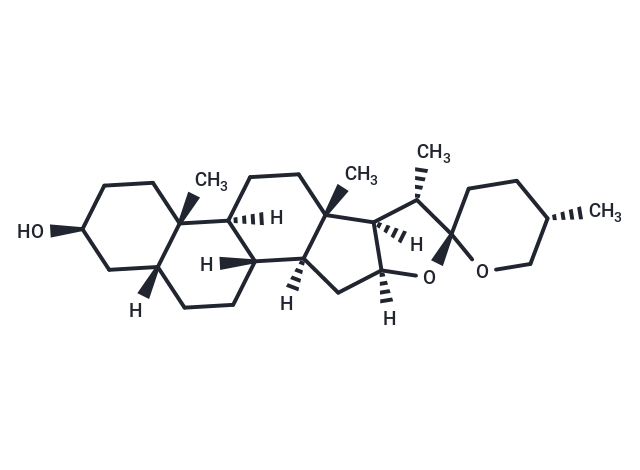Shopping Cart
- Remove All
 Your shopping cart is currently empty
Your shopping cart is currently empty

Sarsasapogenin (Parigenin) is a steroidal sapogenin, that is the aglycosidic portion of a plant saponin. It is named after sarsaparilla (Smilax sp.), a family of climbing plants found in subtropical regions. It was one of the first sapogenins to be identified, and the first spirostan steroid to be identified as such.

| Pack Size | Price | Availability | Quantity |
|---|---|---|---|
| 10 mg | $30 | In Stock | |
| 25 mg | $56 | In Stock | |
| 50 mg | $78 | In Stock | |
| 100 mg | $113 | In Stock | |
| 500 mg | $273 | In Stock |
| Description | Sarsasapogenin (Parigenin) is a steroidal sapogenin, that is the aglycosidic portion of a plant saponin. It is named after sarsaparilla (Smilax sp.), a family of climbing plants found in subtropical regions. It was one of the first sapogenins to be identified, and the first spirostan steroid to be identified as such. |
| Alias | Sarsagenin, Parigenin |
| Molecular Weight | 416.64 |
| Formula | C27H44O3 |
| Cas No. | 126-19-2 |
| Smiles | C[C@@H]1[C@@]2(CC[C@@H](CO2)C)O[C@]3([H])[C@@]1([H])[C@@]4([C@@]([C@@]5([H])[C@]([C@@]6([C@](C[C@H](CC6)O)([H])CC5)C)([H])CC4)([H])C3)C |
| Relative Density. | 1.11g/cm3 |
| Storage | Powder: -20°C for 3 years | In solvent: -80°C for 1 year | Shipping with blue ice. | ||||||||||
| Solubility Information | DMSO: 1 mg/mL (2.4 mM), Sonication is recommended. H2O: Insoluble | ||||||||||
Solution Preparation Table | |||||||||||
DMSO
| |||||||||||

Copyright © 2015-2025 TargetMol Chemicals Inc. All Rights Reserved.